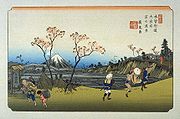
Omiya-shuku
Encyclopedia

69 Stations of the Nakasendo
The are the rest areas along the Nakasendō, which ran from Nihonbashi in Edo to Sanjō Ōhashi in Kyoto. The route stretched approximately and was an alternate trade route to the Tōkaidō.-Stations of the Nakasendō:...
of the Nakasendō
Nakasendo
The , also called the , was one of the five routes of the Edo period, and one of the two that connected Edo to Kyoto in Japan. There were 69 stations between Edo and Kyoto, crossing through Musashi, Kōzuke, Shinano, Mino and Ōmi provinces...
. It is located in the Ōmiya ward
Omiya-ku, Saitama
is a ward of Saitama city, Saitama Prefecture, Japan. It is in the Greater Tokyo Area and about 25 km north of central Tokyo. Ōmiya-ku is surrounded by Nishi-ku , Kita-ku , Minuma-ku , Urawa-ku , Chūō-ku , and Sakura-ku of Saitama city.Ōmiya-ku is the most active commercial and business centre in...
and Kita ward
Kita-ku, Saitama
is a ward of Saitama city, Saitama Prefecture, Japan, occupying the northern part of the city. It is surrounded by Minuma-ku , Ōmiya-ku , Nishi-ku of Saitama city and Ageo city .-History:...
of the present-day city of Saitama
Saitama, Saitama
' is the capital and the most populous city of Saitama Prefecture in Japan, situated in the south-east of the prefecture. Its area incorporates the former cities of Urawa, Ōmiya, Yono and Iwatsuki. It is a city designated by government ordinance...
, Saitama Prefecture
Saitama Prefecture
is a prefecture of Japan located in the Kantō region of the island of Honshu. The capital is the city of Saitama.This prefecture is part of the Greater Tokyo Area, and most of Saitama's cities can be described as suburbs of Tokyo, to which a large amount of residents commute each day.- History...
, Japan
Japan
Japan is an island nation in East Asia. Located in the Pacific Ocean, it lies to the east of the Sea of Japan, China, North Korea, South Korea and Russia, stretching from the Sea of Okhotsk in the north to the East China Sea and Taiwan in the south...
.
History
Larger than its two neighboring post towns, Urawa-shukuUrawa-shuku
was the third of the sixty-nine stations of the Nakasendō. It is located in Urawa-ku in the present-day city of Saitama, Saitama Prefecture, Japan. Its stone ruins can be found 300 meters from Tsuki Shrine . Presently, there is a flea market that takes place on the fourth Saturday of every...
and Ageo-shuku
Ageo-shuku
was the fifth of the sixty-nine stations of the Nakasendō. It is located in the present-day city of Ageo, Saitama Prefecture, Japan.-History:Originally built as a rest area for the Late Hōjō clan, Ageo-shuku became a station on the Nakasendō in 1603. Though it was comparatively small in terms of...
, Ōmiya-shuku was recorded to have had a population of over 1,500 people with over 300 homes during the Tenpō
Tenpo
was a , also known as Tempō, after Bunsei and before Kōka. The period spanned the years from December 1830 through December 1844...
era. It also had the largest number (nine) of secondary honjin
Honjin
thumb|250px|The honjin at [[Inaba Kaidō]]'s [[Ōhara-shuku]]. is the Japanese word for an inn for government officials, generally located in post stations during the later part of the Edo period.-Evolution of Honjin:...
along the Nakasendō.

